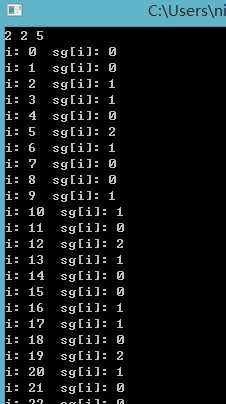标签:
| Time Limit: 2000MS | Memory Limit: 65536KB | 64bit IO Format: %I64d & %I64u |
Description
Input
Output
Sample Input
2 2 5 3 2 5 12 3 2 4 7 4 2 3 7 12 5 1 2 3 4 5 3 2 5 12 3 2 4 7 4 2 3 7 12 0
Sample Output
LWW WWL
经典的Nim游戏题目中已经给出了——每一堆选取的数量没有限制。
S-Nim游戏仅仅是限制了每一次从每一堆中选取的个数,依旧用sg函数计算即可。
经典的Nim游戏中sg(x) = x,所以结果就是每一堆的状态直接xor即可,S-Nim游戏先计算每一堆的sg函数值,然后判断方法依旧是用xor。
#include <iostream> #include <cstring> #include <algorithm> using namespace std; #define N 102 int n,m,l,s[N],sg[10005],ans,a; bool vis[10005]; void c() { sg[0]=0; for(int i=1;i<=10000;i++) { memset(vis,0,sizeof(vis)); for(int j=0;j<n&&s[j]<=i;j++) vis[sg[i-s[j]]]=1; for(int x=0;x<=10000;x++) if(!vis[x]) { sg[i]=x; break; } } } int main() { while(cin>>n&&n) { for(int i=0;i<n;i++) cin>>s[i]; sort(s,s+n); c(); cin>>m; while(m--) { ans=0; cin>>l; while(l--) { cin>>a; ans^=sg[a]; } if(ans) cout<<"W"; else cout<<"L"; } cout<<endl; } return 0; }
对sg函数的理解:
#include <iostream> #include <cstring> #include <algorithm> using namespace std; #define N 102 int n,m,l,s[N],sg[10005],ans,a; bool vis[10005]; void c() { sg[0]=0; for(int i=1;i<=10000;i++) { memset(vis,0,sizeof(vis)); for(int j=0;j<n&&s[j]<=i;j++) vis[sg[i-s[j]]]=1; //里面的sg[]是sg[i]的后继 vis[sg[]] 指的是求mex for(int x=0;x<=10000;x++) if(!vis[x]) { sg[i]=x; break; } } } int main() { while(cin>>n&&n) { for(int i=0;i<n;i++) cin>>s[i]; sort(s,s+n); c(); for(int i=0;i<30;i++) cout<<"i: "<<i<<" sg[i]: "<<sg[i]<<endl; /*cin>>m; while(m--) { ans=0; cin>>l; while(l--) { cin>>a; ans^=sg[a]; } if(ans) cout<<"W"; else cout<<"L"; } cout<<endl;*/ } return 0; }

让我们再来考虑一下顶点的SG值的意义。当g(x)=k时,表明对于任意一个0<=i<k,都存在x的一个后继y满足g(y)=i。
也就是说,当某枚棋子的SG值是k时,我们可以把它变成0、变成1、……、变成k-1,但绝对不能保持k不变。
不知道你能不能根据这个联想到Nim游戏,Nim 游戏的规则就是:每次选择一堆数量为k的石子,
可以把它变成0、变成1、……、变成k-1,但绝对不能保持k不变。这表明,如果将n枚棋子所在的顶点的 SG值看作n
堆相应数量的石子,那么这个Nim游戏的每个必胜策略都对应于原来这n枚棋子的必胜策略!
HDU1536&&POJ2960 S-Nim(SG函数博弈)
标签:
原文地址:http://www.cnblogs.com/Ritchie/p/5620364.html